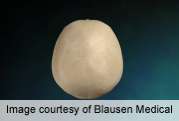Positional plagiocephaly about 46 percent at two months

(HealthDay)—For infants presenting at their 2-month well-child check, the incidence of positional plagiocephaly is estimated at close to 50 percent, and parents should be educated about development and prevention earlier, according to a study published online July 8 in Pediatrics.
To examine the incidence of positional plagiocephaly in infants aged 7 to 12 weeks, Aliyah Mawji, R.N., Ph.D., from Mount Royal University in Calgary, Canada, and colleagues conducted a prospective cohort study involving 440 healthy full-term infants who presented at 2-month well-child visits in four community health centers from July to September 2010.
The researchers identified some form of plagiocephaly in 205 of the infants, with incidence estimated at 46.6 percent. Most of the infants (63.2 percent) were affected on the right side, and 78.3 percent had a mild form of plagiocephaly.
"The high incidence of positional plagiocephaly indicates that intervention in the form of parental education about how to prevent the development of positional plagiocephaly is warranted before infants arrive at the 2-month well-child clinic [visit]," the authors write.
More information:
Abstract
Full Text (subscription or payment may be required)
Health News Copyright © 2013 HealthDay. All rights reserved.
















